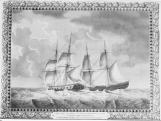15
Also in1679, a discovery was made that helped develop the Newmans' wine trade and heighten the importance of their Newfoundland plantations. That autumn, a Newman & Roope vessel was headed from Portugal to London with a cargo of port when it was sighted by a French privateer. The privateer immediately gave chase. The vessel escaped but was driven miles off course in the mid-Atlantic, and encountered stormy weather. The captain decided to seek safety at the Newman plantations in Newfoundland. The storm-driven vessel spent the winter in St. John's, and finally made its way to Britain in the spring. Astonishingly, the wine had acquired a smoother, fuller flavor during the adventure. Unsure if it was the double passage across the choppy Atlantic or the time spent in Newfoundland's damp climate, the company decided to repeat the entire process. They began sending vast quantities of Newman's finest port to mature in Newfoundland every year.16
Newman Wine Vaults Provincial Historic Site, Water Street, St. John's.20 July 2005
Newman Wine Vaults, St. John's, NL

17
For a number of years the Newmans stored the port in caves or warehouses, but as the trade expanded they moved their enterprise into the Newman Wine Vaults on the west end of Water Street, St. John's."The Newman Wine Vaults is one of the oldest structures remaining in St. John's. The exact date of its construction remains unknown. The earliest record of the Vaults appears on an 1807 map of St. John's, but archaeologists found tobacco pipes in the Vaults dating back to the 1780s. This indicates that the structure may have been built in the eighteenth century."
18
Newman and Company sign over the main door of the Vaults.1 August 2005
Newman Wine Vaults, St. John's, NL

19
In 1700, Newman & Roope was absorbed into Newman & Company. Between 1730 and 1775, the business in Newfoundland was run by brothers Richard and Robert Newman. Richard conducted the business in Conception Bay, while Robert oversaw operations in St. John's and on the south coast. Between them they operated a fleet of about 10 vessels. When Robert died in 1776, his son John reorganized the firm as John Newman & Company. Upon his death in 1779, the company became Robert Newman & Company. By the early nineteenth century they opened branches at the outports of Little Bay and Burin.21
Each spring in Dartmouth the Newman Company would recruit "pauper- apprentices" to come to Newfoundland for an eighteen month apprenticeship. In 1774 it was said that Devon and Dorset supplied "lads from the plough, men from the threshing floor and persons of all sizes, trades and from the manufactories [who] flock annually, in the Spring, to Newfoundland [in] hope of returning with six or ten pounds [from] the land of fish." (From New Maritime History of Devon, Ed. M. Duffy,1992)22
The apprentices, known as "green-men" came from parishes such as Ashburton, Chudleigh, Hennock, South Bovey and Okehampton. They were given the option of returning to England or remaining in Newfoundland, after they served their apprenticeship. Most decided to stay, given the conditions to which they would return in North Devon and Dorset. They became the early planters of Newfoundland's coast and a large portion of the present population can trace their ancestors back to "green-men."24
With the growing resident population, Newman & Company made more profit from the goods they supplied the fisherman than the fish itself. By the 1850's, offices at Burgeo, Gaultois and Harbour Breton were handling the fishery trade, while the St. John's office operated the wine business. Newman & Co agents were appointed to oversee the wine trade, and in 1848 they moved into a building next to the vaults.25
The Newman Building at 1 Springdale Street (intersecting with Water Street), St. John's today.21 July 2005
St. John's, NL

26
This building is now known as the Newman Building, a Provincial Registered Heritage Structure. Today, it provides office space for cultural sector organizations.27
Property marker with initials R.L.N which, stand for Robert Lydston Newman.1890
Newman Wine Vaults, St. John's, NL



